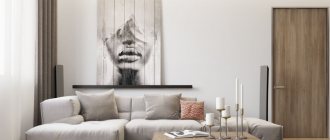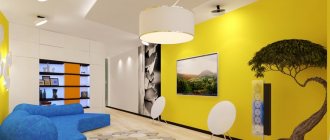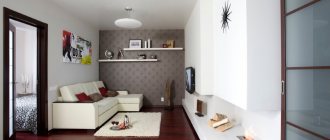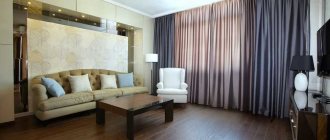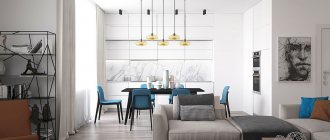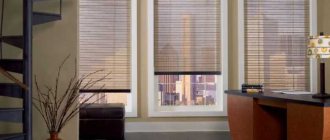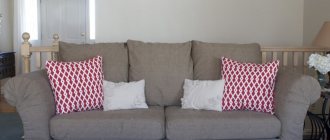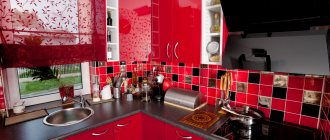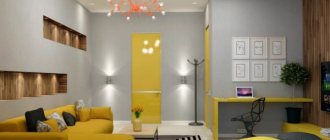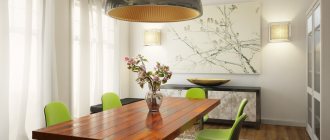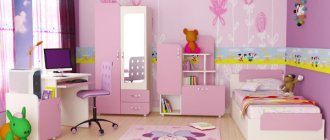Yellow color symbolizes a feeling of warmth and sunny comfort.
Modern designers prefer to use yellow to decorate living spaces.
The room turns out to be a fairly bright and comfortable space. It's a pleasure to be here and have family gatherings.
The living room in yellow light allows you to plunge into an atmosphere of lightness and unsurpassed comfort.
The intensity of the color palette can be adjusted based on the age category.
For older people, light yellow shades are considered the most suitable. Bright and rich colors are suitable for the younger generation.
The main advantages of yellow
The color yellow has a number of benefits that have a positive effect on the human subconscious. These include:
- charges with a positive mood;
- has a tonic effect on a person’s psychological subconscious;
- increases performance;
- allows you to unleash your creative skills.
Quite often, creative and ambitious people prefer a warm palette.
Notes of joy and enthusiasm
You can use yellow as a background or just as a rich accent, you can do both. This approach to color will appeal to those who love a palette of sunny, joyful colors: from lemon to dark yellow, which are reminiscent of the beginning of dawn.
Bold stripes of bright color in combination with other colors besides black will become an extremely interesting option. But you can only leave rugs or sofa cushions with such sunny colors.
Combination of yellow with other colors
Modern technologies make it possible to obtain a fairly diverse color spectrum of shades of yellow. All shades of the pastel palette are considered an excellent combination.
Many designers prefer to choose the safe option of beige and light yellow.
You can add bright accents using a more saturated tone. Mustard textiles against a neutral color scheme add an element of luxury to the living room space.
You can complement the interior with snow-white decorative elements. These can be figurines, vases or beautiful photo frames.
Darker tones of cool shades create a unique design.
Experienced designers advise combining dark blue and purple colors. Yellow in this composition adds a bit of warmth to a dark interior.
Types of wallpaper
There are about a dozen types, depending on the material from which the coating is made. Let's list the most common ones.
- Paper ones are inexpensive, environmentally friendly, suitable for most rooms, except for rooms with high humidity. There are rulers for painting. The main disadvantage is fragility.
- Vinyl - can be paper or non-woven backed. Quite durable and wear-resistant, as they consist of two layers. They are non-toxic and are not afraid of fungus and mold. There are moisture-resistant models, so they are suitable for any room, including the kitchen and bathroom.
- Non-woven fabrics are an environmentally friendly covering, consisting of a bottom substrate (non-woven fabric) and a top layer. It can be vinyl or non-woven. The first option is more budget-friendly, is not afraid of water and mechanical stress, and lasts a long time. The second, in addition, allows air to pass through, thanks to which the walls “breathe” and the appearance of fungus or mold is excluded. That is why non-woven fabrics are recommended for use in children's rooms.
- Textile - also have two layers: paper or non-woven fabric at the base and textile fabric on top. For the decorative layer, linen, viscose or cotton are most often used. The main advantages are a beautiful appearance, as well as good noise and heat insulation. Disadvantages include the relatively high price and the need for careful maintenance: this coating is sensitive to dirt and easily collects dust.
- Fiberglass is a modern wall covering made from special glass threads that form a strong and durable coating. This type is hypoallergenic, reliable and resistant to mechanical stress. Well masks uneven walls. This coating itself has no color; it can always be painted.
- Liquid - combine the functions of wallpaper, plaster and paint. They are sold as a dry mixture, which is diluted with water and applied to the walls like a regular finish. They have good sound and heat insulation, are easy to clean, and environmentally friendly. The downside is that the coating takes a long time to dry and also absorbs moisture, so it is better to use them in residential areas.
Instagram @kitandco_
Instagram @enjoy_home
Living room decoration
Excessive amounts of yellow color can cause prolonged depression. In order not to overload the interior space of the living room, it is recommended to use a sunny shade as bright accents and decorative elements.
Furniture in neutral colors (gray, tan or white) helps complement the cozy atmosphere of the reception area.
The walls should have a pastel color. A yellow carpet adds a pop of color to your living room.
Textiles in warm shades of yellow (mustard, lemon) sets a positive mood for the entire interior space.
In the reception area, just add a few accent pieces to create a stylish stop.
Psychology of color
Colors have a strong influence on people, and this is due to the associative series.
To explain our own attitude towards the color yellow, it is enough to remember where it catches our eye most often. And Mother Nature loves him very much. Yellow is the rays of the sun, dandelion fields, sand dunes, ripe bananas, exotic birds and fish. It exudes warmth, attracts attention, and in its brightest shades literally screams and is insolent. This is the difficulty of using yellow color in interiors: it will never agree to play second roles and, being in excess, will quickly get boring, or even completely reduce the design concept to bad taste.
Psychologists have discovered interesting properties of this color:
- invigorates, inspires optimism and sets you up for productive work;
- promotes concentration and memorization of large amounts of information;
- makes any room seem lighter, warmer and more comfortable, visually expands the walls and raises the ceilings.
Sociable, active, expressive, self-confident people, whose lives are filled with movement and bright emotions, feel good in yellow rooms. But for those prone to melancholy, calm and thoughtful natures, yellow walls will put pressure on the psyche, irritate and even provoke headache attacks.
The photo shows a stylish living room, where the yellow color of the walls is repeated in furniture and decorative elements and contrasts well with black details
What furniture to choose?
Furniture for the living room should be selected in accordance with the chosen stylistic direction. The classic style is characterized by the presence of natural solid wood in the interior space. The color scheme is made in light yellow or dark shade.
For a high-tech style, it is recommended to choose multifunctional furniture accessories that will save space. The surface of such objects has a leathery or dense texture.
The yellow set adds sophistication to the living room design.
As for the fittings, it should have a large number of chrome elements. The legs of a furniture design can be thin or, on the contrary, massive.
Yellow as decoration
Various details made in a sunny palette help to dilute the light white living room. Yellow curtains or drapes create an unrivaled ambience in a room's design.
The presence of additional tiebacks of a darker shade acts as a bright accent. You can supplement the composition using:
- floor vase;
- a beautiful lamp;
- paintings in a bright yellow frame.
As you can see, everything is quite simple. The main thing in the decorating process is not to overdo it with bright colors.
A competent combination of colors guarantees the desired result.
Examples in the interior of rooms
The living room gives this color probably the widest scope for expression. Pale yellow tones are ideal for walls, while more saturated ones are ideal for furnishings and decor. Since this room is the “face” of the house, feel free to choose all kinds of yellow accessories for it: rugs, flowerpots, paintings, pillows, floor lamps.
A bedroom in yellow tones, especially bright ones, is a dubious decision. This is the color of intelligence, motor activity and ebullient energy, and in the bedroom both the brain and the body should relax. Although, many people like pleasant pastel shades of yellow and do not at all interfere with a restful sleep.
A children's room is traditionally decorated in bright, cheerful colors, especially if we are no longer talking about a baby, but about a tomboyish preschooler. So some rich yellow elements will be quite appropriate, but you shouldn’t completely paint the walls in this color - it will disturb the child and prevent him from getting ready to relax in the evenings.
The kitchen is truly an ideal haven for any shades of yellow, not only the acidic ones, favored by fans of hi-tech and minimalism. Many products have a natural yellowish color (cereals, beans, butter, fruits and vegetables), and the interior in “edible” colors has a positive effect on appetite and inspires delicious cooking.
The bathroom is another suitable springboard for yellow. Entering such a room early in the morning, you will instantly wake up, recharge with vigor and positivity, and set yourself up for a fruitful working day. However, it is better to dilute the yellowness with a white or light gray background.
Surely there are people who, under no circumstances, would decide to use yellow in the design of their home. At the same time, there are devoted fans of this sunny, life-affirming color, ready to surround themselves with it to the maximum. If you are one of them, go for it!
